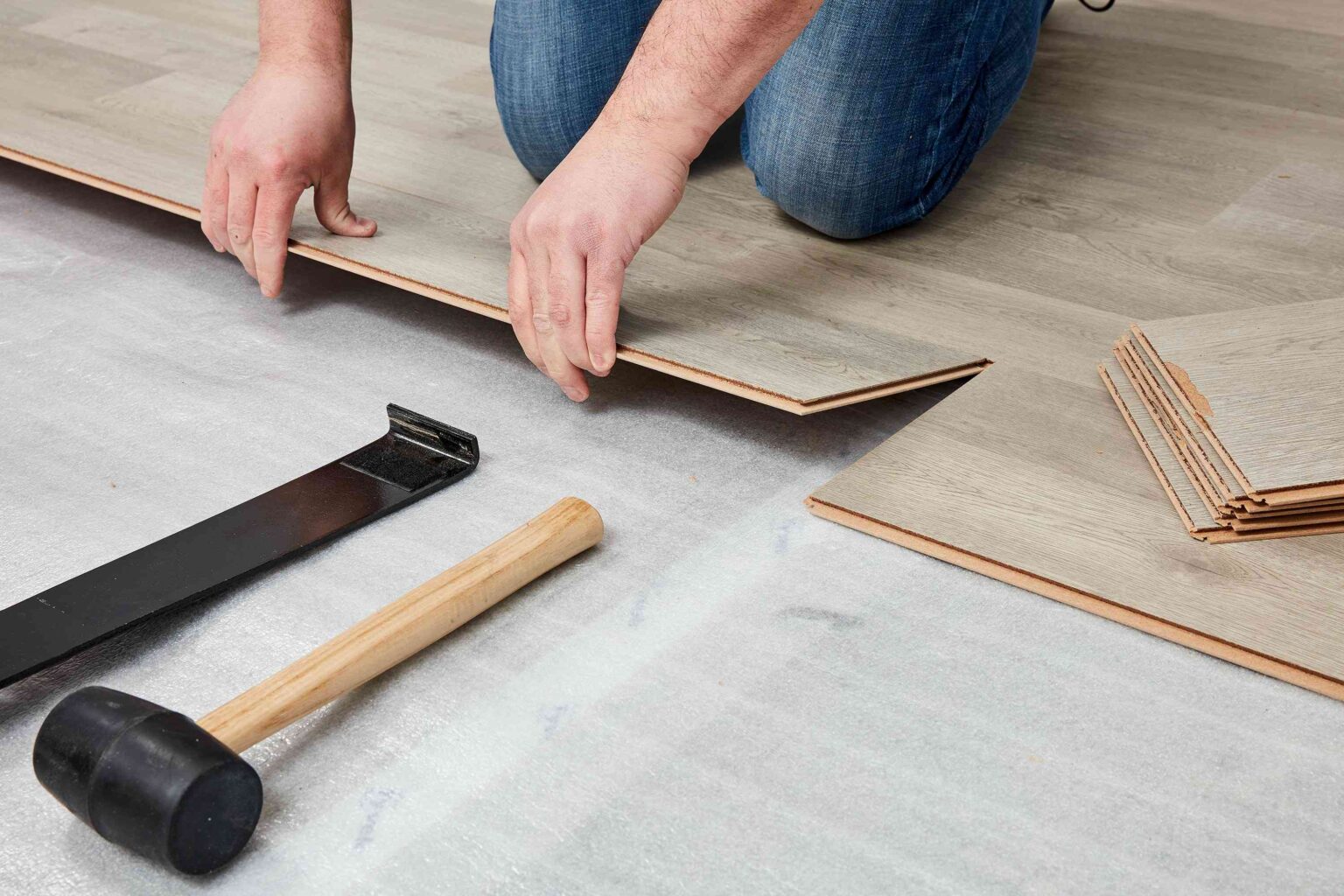Underlayment is necessary for laminate floors because it smooths uneven surfaces, absorbs sound, and controls moisture.
Learn about underlayment for laminate flooring and installation basics.
What Is Laminate Underlayment?
Laminate underlayment is a soft pad underneath laminate flooring. It helps the planks lay smoother and connect better and makes the flooring feel slightly softer underfoot. Underlayment is either pre-attached to the bottom of the laminate flooring or added separately by the installer.
The Spruce / Kevin Norris
Attached vs. Separate Underlayment
- Pre-attached underlayment: Pre-attached underlayment is a thin, bonded layer on the bottom of laminate planks. No additional underlayment is needed, and the laminate flooring is ready for installation.
- Separate underlayment: Rolls of foam, felt, or cork underlayment must be purchased and installed separately. Separate underlayment provides a more cohesive moisture barrier under the laminate planks than the pre-attached version.
Underlayment Materials and Sizes
- Materials: Polyethylene foam, felt, or cork
- Width: 36 to 44 inches wide
- Length: 30 to 100 feet long
- Thickness: 2 mm to 3 mm
Benefits of Laminate Flooring Underlayment
Laminate flooring is thin and is constructed of fiberboard rather than solid hardwood or plywood, as with engineered wood flooring. Underlayment is a recommended supplement unless it is already bonded to the bottom of the planks.
Corrects Imperfections
Subfloors are often not perfectly flat and featureless. Subfloors exposed after removing the existing flooring are often dotted with nail holes, pits, gaps, grooves, and splinters. Even new subflooring can be considered imperfect since the OSB or plywood sheets are seamed.
Laminate flooring will eventually telegraph (transmit or duplicate) subfloor imperfections. Underlayment helps to prevent this laminate damage.
Softens Footfall
When you are installing on top of hard surfaces such as concrete, you may want the extra padding that underlayment provides to make it softer to walk on. Wood subflooring has enough flexibility that underlayment will only slightly soften the surface of the laminate. But concrete, brick, and other forms of masonry practically demand the softening qualities that underlayment can provide.
While laminate underlayment softens your footfall, it can also make the flooring feel hollow. It is a feeling that is apparent when you walk from a solid surface, such as tile, to a laminate floor with underlayment.
Absorbs Sound
Laminate flooring needs extra help from the underlayment to feel and act like real wood. Consider the issue of sound transmission. You do not need foam padding under solid hardwood for many reasons, but one reason is that hardwood is so dense that it limits sound transmission, both within the room and to floors below.
Laminate flooring is usually no more than 12mm thick and is made of a type of low-density fiberboard. The underlayment will help boost the laminate’s sound-absorbing qualities, but only minimally.
Controls Moisture
You will need moisture-proof underlayment or vapor barrier when moisture will likely migrate upward from a concrete slab, tile, or cement board. Even a wood subfloor or flooring over a crawlspace or other non-climate-controlled space can be subject to rising moisture.
Common foam underlayment will inhibit moisture, but some types require an additional 6 mil. polypropylene vapor barrier. Flooring underlayment that includes a waterproof layer is also available.
Laminate Underlayment Installation
Learn a few basics of installing laminate underlayment:
Cost
Foam underlayment costs about $1 per square foot.
When Not to Install Underlayment
Never add separate underlayment under laminate flooring that has pre-attached underlayment. This will result in loose, wobbly laminate planks.
How to Install It
- Fix the floor: Laminate underlayment cannot cure all imperfections. Large gaps need to be fixed. To correct large depressions, fill low spots with a liquid leveling compound that later hardens.
- Roll it out: Roll out the sections of underlayment side by side. Let the underlayment ride a few inches up the wall.
- Overlap the rows: Self-adhesive underlayment rows must be overlapped so the adhesive edge can stick to the adjacent underlayment row. Leave the protective strips in place until all of the underlayment has been rolled out.
- Attach the rows: When the layout looks good to you, remove the strips to reveal the adhesive and attach the rows.
- Cut excess: Cut the excess underlayment with a utility knife.
When Thicker Underlayment is Needed
Laminate flooring with denser felt underlayment more closely approximates the feeling of real wood flooring. Premium felt underlayment will cost more than foam, but it provides better sound absorption.
The Spruce / Kevin Norris
FAQ
-
Can you install laminate flooring without underlayment?
The only instance when you do not need underlayment is when the laminate flooring already has underlayment attached to its bottom. Otherwise, underlayment is recommended underneath the planks.
-
What’s the most budget-friendly underlayment for laminate flooring?
Foam is the most budget-friendly underlayment for laminate flooring. Foam is cheaper than the other underlayment options: felt or cork.
-
How thick should laminate underlayment be?
Laminate underlayment should be 2 mm to 3 mm thick.
Read the full article here
